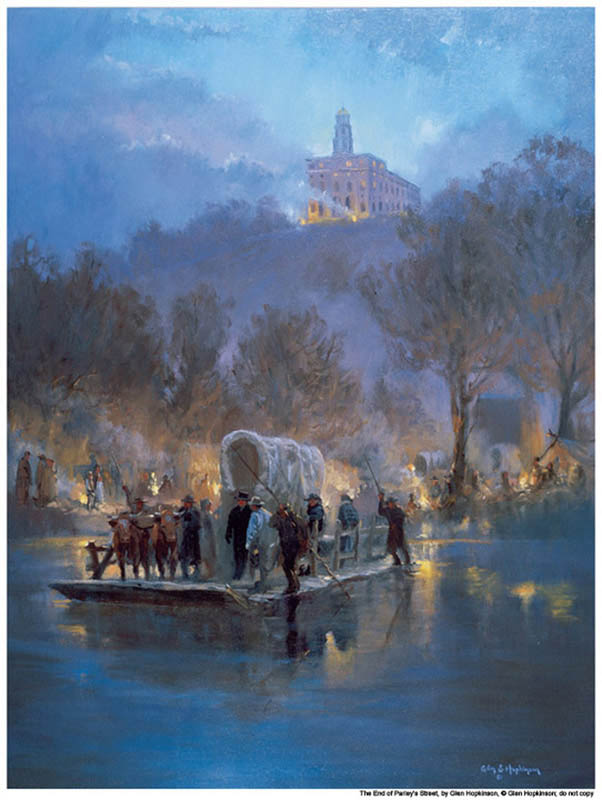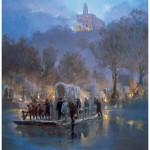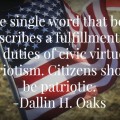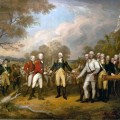Mormons are often noted for their patriotism and for their teaching that the United States Constitution is divinely inspired. What do Mormons mean when they say that?
It’s important to note that different Mormons have different interpretations of the meaning of a divinely inspired constitution. In this article, we’ll discuss some of the views held by various church leaders over the course of modern Mormon history.
The Doctrine and Covenants, a book of modern revelation given to Mormon leaders, discusses the United States Constitution in section 101. This revelation was given at a time when Mormons were experiencing great persecution from individuals and from the Missouri state government. They are the only religious group to have had an extermination order on their heads in the United States. Many Mormons, having faced death, having coped with the loss of property and crops, having been driven from their homes multiple times, and having faced other challenges to their freedom, must have wondered about the Constitution and its protections against religious persecution. It was in this setting Joseph Smith received the following revelation:
77 According to the laws and constitution of the people, which I have suffered to be established, and should be maintained for the rights and protection of all flesh, according to just and holy principles;
78 That every man may act in doctrine and principle pertaining to futurity, according to the moral agency which I have given unto him, that every man may be accountable for his own sins in the day of judgment.
79 Therefore, it is not right that any man should be in bondage one to another.
80 And for this purpose have I established the Constitution of this land, by the hands of wise men whom I raised up unto this very purpose, and redeemed the land by the shedding of blood. (See Doctrine and Covenants 101.)
The Mormon Guide to the Scriptures states that the Constitution “was divinely inspired in order to prepare the way for the restoration of the gospel.”
This then is the official meaning of the divinely inspired constitution. It was inspired for the purpose of bringing forth the gospel, which means that the portions of the Constitution designed to do this were inspired. The other portions are open to personal interpretation. Individual members and leaders have held varying opinions as to which portions of the Constitution are required for this to happen.
Joseph Smith, frustrated to learn the Constitution did not authorize the federal government to force states to obey the Constitution—an oversight which cost many Mormon lives—said, “Its sentiments are good, but it provides no means of enforcing them. … Under its provision, a man or a people who are able to protect themselves can get along well enough; but those who have the misfortune to be weak or unpopular are left to the merciless rage of popular fury.” (See The Divinely Inspired Constitution by Dallin H. Oaks.) Elder Oaks, a current Mormon apostle, pointed out this was remedied by the fourteenth amendment after the Civil War.
Elder Oaks is especially qualified to speak on the Constitution. He is a former state Supreme Court justice and helped to draft the Bill of Rights for the Illinois Constitutional Convention in 1970. He gave the above-mentioned talk in 1992 and explained he was discussing the Constitution in that position, not as an official statement of Mormon beliefs. In his opinion, some, but not all the Constitution was divinely inspired:
“Personally, I have never considered it necessary to defend every line of the Constitution as scriptural. For example, I find nothing scriptural in the compromise on slavery or the minimum age or years of citizenship for congressmen, senators, or the president. President J. Reuben Clark, who referred to the Constitution as “part of my religion,” also said that it was not part of his belief or the doctrine of the Church that the Constitution was a “fully grown document.” “On the contrary,” he said, “We believe it must grow and develop to meet the changing needs of an advancing world.”
Elder Oaks considered five parts of the Constitution to be inspired. His list consisted of these items:
- Separation of powers (between branches of federal government)
- A written Bill of Rights
- Division of powers (between federal and state)
- Popular Sovereignty
- The rule of law and not of men.
This talk is one of three LDS.org, the official Mormon site for church members, recommends when you search for information on the Constitution. The second talk recommended is by Ezra Taft Benson, who served as Secretary of Agriculture prior to serving as a Mormon apostle and later as its prophet and president.
You can read this talk here:
Ezra Taft Benson, “The Constitution—A Glorious Standard“, Ensign, Sept. 1987, 6
President Benson also quotes Joseph Smith, again in Missouri, but this time unfairly imprisoned for, essentially, being a Mormon. “The Constitution of the United States is a glorious standard; it is founded in the wisdom of God. It is a heavenly banner.” It is clear Joseph Smith could honor and celebrate the Constitution even while noting its weaknesses and even while suffering personally for those weaknesses. The weaknesses it has are those of men, not of God. He understood that God made certain that through all the debate, controversy, and compromise that happened at the Constitutional Convention, those elements that were essential were put into place, either at the convention or afterwards during the extraordinary fight for a Bill of Rights and for ratification. Joseph said, “I am the greatest advocate of the Constitution of the United States there is on the earth.” (History of the Church, 6:56–57.)
President Benson focused on the five portions of the Constitution he felt were most important to preserving freedom. These five points were:
- Sovereignty lies in the people themselves.
- Separation of powers between the branches of government.
- Limited power given to each branch of government.
- Representation indirectly and directly.
- The Constitution was designed to work with only a moral and righteous people. (This thought came from John Adams, who was not at the Constitutional Convention but who certainly had a stake in the results.)
He, like Elder Oaks, outlined several principles for protecting the Constitution. Although they sometimes offer different ideas on the subject, they both agree we must protect the divinely inspired portions of the Constitution.
Various prophets and church leaders have had differing opinions on how much of the Constitution is inspired. Some believe it all to be inspired and others only those portions necessary to protect religious freedom. However, all are agreed that the Constitution was indeed part of God’s plan for His church and that we are accountable for our willingness to defend the provisions that protect religious freedoms. They also agreed we must live worthy of God’s protection in order to keep it. Following are some thoughts various church leaders have had concerning the Constitution’s divinity:
“I am grateful for the Constitution of this land. I am grateful that the Founding Fathers made it clear that our allegiance runs to that Constitution and the glorious eternal principles embodied therein. Our allegiance does not run to any man, to a king, or a dictator, or a president, although we revere and honor those whom we elect to high office. Our allegiance runs to the Constitution and to the principles embodied therein” (Conference Report, Oct. 1954, pp. 119–20.)
“If we would maintain the independence and freedom the Founding Fathers intended, we must work to preserve and protect the moral foundation upon which they built the U. S. government. We must stand boldly for righteousness and truth, and must defend the cause of honor, decency, and personal freedom espoused by Washington, Madison, Adams, Lincoln, and other leaders who acknowledged and loved God” (M. Russell Ballard, “Religion in a Free Society“, Ensign, Oct. 1992, 64).
It should be noted the Mormon Church does not support any political party. Faithful members of the church are found in both parties, even in the highest levels of the church. For instance, Ezra Taft Benson was a Republican Secretary of Agriculture. James E. Faust, a counselor to a prophet, was head of the Democratic Party in Utah at one time and remained a Democrat all his life.
“As the Church operates in countries around the world, it embraces the richness of pluralism. Thus, the political diversity of Latter-day Saints spans the ideological spectrum. Individual members are free to choose their own political philosophy and affiliation. Moreover, the Church itself is not aligned with any particular political ideology or movement. It defies category. Its moral values may be expressed in a number of parties and ideologies.” (The Mormon Ethic of Civility, Oct 16, 2009 — Salt Lake City).
Instead, they teach their members in every country to support their government and leaders, to obey laws, and to be involved in government in a civil and participatory way. Each church member is invited to pray to know how to stand on various issues and to choose a political party that best suits their prayerful choices if they decide to join a party. Prayer and ethical behavior are the keys to preserving the American constitution.
About Terrie Lynn Bittner
The late Terrie Lynn Bittner—beloved wife, mother, grandmother, and friend—was the author of two homeschooling books and numerous articles, including several that appeared in Latter-day Saint magazines. She became a member of the Church at the age of 17 and began sharing her faith online in 1992.







